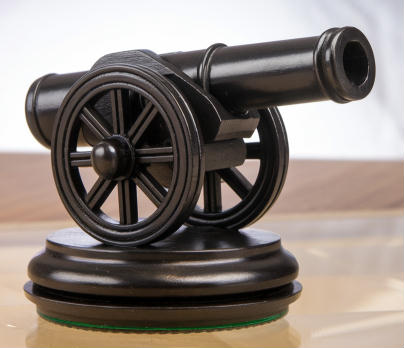Piececlopedia: Cannon
Historical notes
The Cannon comes from Xiangqi, Chinese Chess. It is indiginous to China, where gun powder and cannons were both invented. Fairy Chess problemists commonly call it a Pao, which is a transliteration of its Chinese name. But in Chess variants, it is more commonly called a Cannon.
The Cannon has been used in the following variants. Except for two games by the same person, it has been called a Cannon in every one of these variants.

- Al-Ces by Köksal Karakus
- Cannon Shogi and Cannon Chess by Peter Michaelsen
- Fantasy Grand Chess: Dwarven Army
- Giant Chess by Köksal Karakus (The Cannon is called Shogi in this game)
- Grand Cavalier Chess by Fergus Duniho
- King and Queen by Dennis Xay Voong
- Perfect12 by Jean-Louis Cazaux.
- Shako by Jean-Louis Cazaux.
- Tamerlane II by Jean-Louis Cazaux
- Turkish Chess by Köksal Karakus (The Cannon is called Shogi in this game)
- Xhess by David Howe
- Yáng Qí by Fergus Duniho
- Eurasian Chess by Fergus Duniho
- Gross Chess by Fergus Duniho
- Metamachy by Jean-Louis Cazaux.
Movement
When the Cannon does not take, it moves like a Rook, i.e., on an orthogonal line an arbitrary number of empty squares. When it takes, it must jump: when taking, the Cannon also moves over an orthogonal line, jumps over the first piece it meets (which may either be friendly or from the opponent) and then continues over the line until the next piece it sees: if that is from the opponent, the Cannon can take it by moving to that position.
Movement diagram
The diagram above shows the Cannon's legal moves. The Cannon on d5 can take the Bishop on b5 or the Rook on d1, and it can move to any other space marked with a square border inside it.
Vocabulary: Screen
To make a capture, a Cannon must jump over a screen. This is an intervening piece, which may be of either color, that must stand between the Cannon and its target. Without a screen between the Cannon and its target, it cannot capture the piece. The Cannon moves as a Rook without capturing, and once it jumps over its screen, it continues along as a Rook but only to capture. It cannot jump the screen to make a non-capturing move. When a Cannon attacks, it can be blocked by two pieces, or the opponent can defuse the Cannon's attack by moving the screen out of its path.
While a Cannon uses a screen only for capturing, another type of piece, known as a hopper, requires a screen for both moving and capturing. The best known hopper is the Grasshopper. Other pieces that use a screen only for capturing include the Vao and the Leo.
Checkmating
The Cannon cannot inflict checkmate on a rectangular board with only assistance of its own King, (and neither can a pair of them), and is thus a minor piece. The problem here is that it needs an extra piece to use as a screen to activate its captures. Once these can get activated the Cannon is pretty strong. Hence a weak piece such as a Ferz is already a suitable partner. You can practice this here.
Images
Click on an image to view the full piece set it belongs to.
|
|
||||||||||||
Printable Pieces
The following designs are available for printing on a 3D printer. Links are to Thingiverse.
This is an item in the Piececlopedia: an overview of different (fairy) chess pieces.
Written by Fergus Duniho and Hans Bodlaender. Diagram by Ben Good.
WWW page created: September 7, 1998. Last modified: December 15, 2001.




